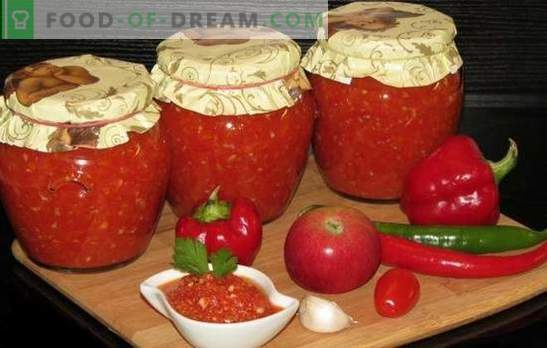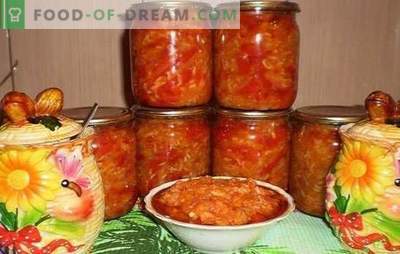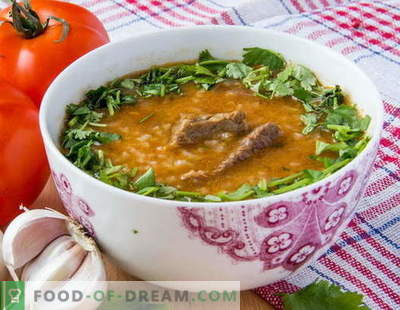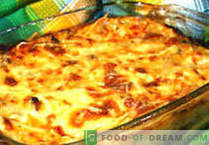
Adjika is a spicy sauce of Georgian-Abkhaz cuisine. It has a fairly pronounced taste with a mixture of garlic, red pepper and spices.
Translated from the Abkhaz language, the word “adjika” means “salt”.
There are a lot of recipes for its preparation, the first and classic ones include hot red pepper, garlic, salt and coriander.
Adjika is a natural preservative and therefore can be stored for a long time.
General principles of cooking adzhika for the winter
There are many variations of this wonderful sauce, each hostess has its own secret. However, only some of the ingredients that are added or removed at will differ, the basic principles of manufacturing always remain the same:
1. Almost every adjika recipe for the winter includes adding tomatoes or tomato paste. Without them, the taste will be changed beyond recognition.
2. All ingredients should be chopped through a meat grinder or blender. Cutting with a knife will not allow vegetables to soak and boil well, and the use of a grater will take too much time and effort.
3. In the manufacture of adzhika, it is necessary to observe sterility in spite of the fact that all the ingredients used are of the first freshness. All dishes used should be thoroughly washed with soda, dried and wiped thoroughly with clean towels. Because of the remainder of the raw water, the sauce can sour very quickly.
Adjika with the addition of sour apples
This adjika is equally suitable for borscht or potato dishes, as well as for any meat dish.
Ingredients:
• 2 kilos of tomatoes;
• 1 kilo of red, Bulgarian perchin;
• a pound of sour apples;
• a pound of carrot;
• 200 grams of garlic;
• 100 grams of hot chili peppers;
• 1 cup of unrefined vegetable oil;
• 50 grams of ground black pepper;
• 50 grams of salt.
Cooking Method:
Wash and cut all the vegetables, peel the apples. Twist all the ingredients in a meat grinder or blender, add salt, black pepper, oil to the resulting mixture. Pour the mass into a large saucepan and simmer over moderate heat for 2.5 hours, often stirring. Pre-sterilize the jars and roll up the hot adjika. The output will be about 6 cans.
Adjika with zucchini
Quite an interesting recipe with zucchini has a not very sharp taste.
Ingredients:
• 3 kilo zucchini;
• a pound of carrot;
• a pound of red, yellow and green Bulgarian pepper;
• 5 garlic heads;
• 1.5 kilo of tomatoes;
• 2 tablespoons of salt;
• 100 grams of sugar;
• 2.5 tablespoons of ground, hot red pepper;
• 200 grams of refined sunflower oil;
• 100 ml of 9% vinegar.
Cooking Method:
Thoroughly wash the ingredients under running water, chop and send in a meat grinder everything except garlic. Survive the mixture in a saucepan, add sugar, pepper and salt and simmer on low heat for about 40 minutes, stir constantly. Grind or crush the garlic, add to the adjika and simmer another 5 minutes, pour vinegar into the future adjika and leave the mass to adjust for 10 minutes. Roll up the adjika in jars and wrap in warm blankets for a day. It is preferable to let the sauce stand for two weeks in a dark place. If you like sharper flavors - instead of 2.5 spoons of red pepper, you can safely add 3 or 3.5.
Green adjika for the winter
A rather interesting variant of adzhika, which is prepared mainly from green ingredients, but it doesn’t taste much better than the beloved red sauce. Ideal for fish, meat and soup dressing.
Ingredients:
• a pound of green, hot peppers;
• 12 bunches of cilantro;
• 30 garlic cloves;
• 4 tablespoons of salt.
Cooking Method:
Rinse all the ingredients, peel the garlic, remove the seeds from the pepper. Put all the vegetables in a meat grinder or blender, chop, salt. This adjika does not need to be cooked; it can be stored in the refrigerator for a long time. It can be used both as a sauce and for a sandwich filling.
The original Abkhaz adjika for the winter
This recipe is original, it is this version of adzhika that is most common in the Caucasus. Many actually use this adjika as a “salt”, adding it in large quantities to a wide variety of dishes. Ingredients:
• half a kilo of spicy chili;
• 300-400 grams of garlic cloves;
• 50-70 grams of fresh dill and parsley;
• 60 grams of fresh basil;
• 60 grams of fresh coriander;
• 2-3 tablespoons of non-iodized wholemeal salt.
Cooking Method:
Rinse the pepper, dry with a towel. Cut the hats, but the pepper itself does not cut or remove seeds from it. Peel the garlic, wash the herbs. Grind all ingredients using a meat grinder, including garlic, put in a galvanized dish, close tightly and leave for 3-4 days. After this period, pour the adjika into unsterilized jars and tightly close the caps with nylon. Store in a basement or refrigerator.
Siberian adjika with horseradish
This variant of adzhika is ideal as a dressing for lean borscht, as well as for dumplings, mantles, and simply as a dressing for bread.
Ingredients:
• 1 kilo of fresh tomatoes;
• 60 grams of grated horseradish;
• 40 grams of garlic;
• 2 tablespoons of salt;
• 10 grams of sugar.
Cooking Method:
Siberian adjika is also prepared without cooking. All ingredients are washed and chopped using a meat grinder, horseradish chop as a last resort. Add sugar and salt, mix thoroughly for two to three minutes. Pour into containers and close capron caps. Adjika is stored for a long time, in a dark, cool place.
Adjika for the winter with pickles
Unusual recipe, which in no way inferior to the original options and amazingly complement the taste of any meat dishes
Ingredients:
• 12 pieces of pickled cucumbers;
• 15 garlic cloves;
• 6 tablespoons of tomato paste;
• 6 teaspoons of vegetable oil;
• 4 tablespoons of red and black green pepper.
Cooking Method:
Grate cucumbers on the largest grater or finely chop and combine with chopped garlic. In the resulting mass add tomato paste and pepper, mix well. Wrap in a blanket, leave in a dark place for 12 hours. Store in the refrigerator, under the capron cover.
Adjika for the winter with eggplants
This recipe is perfect as a billet for the winter. Preparing is quite simple, from the listed ingredients you get about 5 liter cans.
Ingredients:
• 3 kilos of not very large eggplants;
• 3 kilos of fleshy tomatoes;
• 1 kilogram of sweet pepper;
• 2 garlic heads;
• 2 pieces of hot pepper;
• 2.5 tablespoons of salt;
• 1 cup of sugar;
• 100 ml of 5% or 9% vinegar;
• 1 cup of sunflower oil;
• 2 large bunches of greens.
Cooking Method:
Rinse all vegetables with warm water, peel the garlic, and allow the ingredients to dry. All put in a meat grinder, with the exception of eggplant and greens. Pour the mass into a large saucepan, add sugar with vinegar. Finely chop the greens and also add to the future adjika. Bring the mass to a boil, reduce the heat a little and stir often. Eggplant cut into rings and half rings, not thick or thin. 10 minutes after adjika boil, add eggplants and cook for about half an hour. Pour the mixture into pre-sterilized jars and roll up. Wrap the cans in a blanket and wait for the adzhika to cool completely.
Gentle adjika with added plums
This recipe is suitable for those who are not a big fan of hot sauces.
Ingredients:
• 1 kilo of fresh plums;
• 1 kilo of bell peppers of different colors;
• 1-2 garlic heads;
• 3 pieces of red, burning peppers;
• 1 cup of sugar;
• 2 tablespoons of salt;
• 1 liter of tomato paste;
• 1 teaspoon of 9% vinegar.
Cooking Method:
Wash the pepper, cut and place in a blender or meat grinder. Remove the bones from the plums and also send them to the meat grinder. Finely chop garlic and hot peppers. Put all prepared products in a large saucepan, pour in the paste, add sugar and salt, cook for about half an hour. At the end, pour the vinegar and stew for another 5 minutes. Pour the adjika into prepared containers, roll up, turn over and leave to cool. Try adjika preferable in a couple of days, letting it stand in a dark place.
Adjika for the winter with pears
To taste this version of adzhika is a bit like the version with apples. Most suitable for white poultry dishes.
Ingredients:
• 15 medium tomatoes;
• 1 kilo of carrots;
• 1 kilo of sweet pepper of different colors;
• 10 ripe pears;
• 1 kilo of bulb bulbs;
• 150 grams of garlic;
• 1 cup of refined, sunflower oil;
• 3-4 tablespoons of sugar;
• 3 tablespoons of salt;
• 0.5 cup 7% vinegar.
Cooking Method:
Wash vegetables in warm water, remove seeds. Rinse the pears and trim the stalk. All chopped, chopped to a mushy state through a meat grinder, finely chop the garlic with a knife. The whole mass is mixed, put into a large saucepan, pour in oil, sugar and salt. On moderate heat bring the future adjika to a boil, reduce the heat and often stir the adjika for half an hour. At the end of cooking, pour vinegar into the pan and turn off the heat after 5 minutes. Pour the adjika into sterilized containers and roll up. Keep the sauce in a dark place.
Adjika for the winter with the addition of nuts
This option adzhika can be prepared as a blank for the winter, and as a sauce for the dish in haste.
Ingredients:
• 250 grams of peeled nuts;
• 3 medium tomatoes;
• 1 piece of yellow or orange pepper;
• 3 pieces of red, hot pepper;
• 1 bunch of any greens;
• 3 garlic heads;
• 3 tablespoons of sunflower oil;
• 3 tablespoons of rice vinegar;
• 1 teaspoon salt.
Cooking Method:
Wash the above ingredients, remove the seeds and stalks. Cut the garlic and greens, pour over the tomatoes with hot water and remove the peel. Put all the ingredients in a meat grinder or blender. Add oil, vinegar and salt, stir for 1-2 minutes. Store adjika in a fridge in a can under a capron lid.
Frozen adjika for the winter
This option is ideal for preparing adzhika for the winter, if you do not have a cold storage space in the apartment. Frozen adjika does not lose its taste and spice at all, and after defrosting the taste remains exactly the same as on the first day of cooking. Ingredients:
• 1 kilo of tomatoes;
• 1 kilo of red bell pepper;
• a pound of white onion bulbs;
• a pound of red onion bulbs;
• 10 garlic cloves;
• 2 tablespoons of salt;
• 2 tablespoons of sugar;
• 2-3 pieces of chili pepper;
Cooking Method:
Clean the vegetables from contamination, dry, chop to the state of porridge through a meat grinder. Mix thoroughly, add salt and sugar, mix again. Prepare in advance plastic bottles from under dairy products. Put the adjika in the freezer, if the refrigerator has a quick freeze function, then use it.
Turkish adjika for the winter
Turkish adjika is perfectly combined with pita bread, ideal for kebabs, kebabs, chicken and many other meat dishes.
Ingredients:
• 3 pieces of fresh tomatoes;
• 1-2 pieces of hot chili peppers;
• 2 bunches of fresh parsley;
• 2-3 sprigs of fresh basil;
• 1 teaspoon salt;
• 2 tablespoons of sunflower oil.
Cooking Method:
Finely chop the tomatoes with greens, remove the seeds from the pepper. Grind all the vegetables in a blender. Put the ingredients in a storage container, add oil and salt. Adjika can be prepared in small quantities for a specific dish, or it can be harvested more and stored in the refrigerator under a nylon cap in winter.
Adjika with pumpkin
Another unusual recipe that has an unusual but no less interesting taste. Ideal for potato dishes.
Ingredients:
• 1 kilo of pumpkin;
• 1 large apple;
• 2 pieces of Bulgarian Perchin;
• 1 bulb onion;
• 5 garlic cloves;
• 15 grams of fresh oregano;
• 30 grams of olive oil;
• 1 teaspoon salt;
• 1 teaspoon of black pepper;
• 1 lemon;
• 2 pieces of red hot pepper.
Cooking Method:
Wash and dry all vegetables. Wrap each ingredient in foil, preheat the oven to 200 degrees for about 20 minutes. In a blender, chop the garlic, lemon and oregano. After cooking the pumpkin, squeeze it through cheesecloth and chop it in a blender, then chop the rest of the vegetables. Combine the mixture with garlic and lemon, mix thoroughly. Adjika can be used both hot and cold, it is stored in a closed container for quite a long time.
Tips and tricks for cooking adzhika for the winter:
1. It is preferable to choose yellow pepper, as it is the most fragrant. Adjika may turn out to be less red, but with a much more interesting taste.
2. Before pouring the adjika into prepared containers, get rid of excess water and juice using a colander.
3. Garlic for adzhika choose with a purple hue, and salt - larger, it is permissible to use sea.
4. To soften the spice, apples or pears are added to the sauce.
5 Remove all the seeds from the pepper, if you want a less pungent taste.
6. For a more intense flavor, lightly heat all the spices in the pan that you are going to add to the adjika — they will highlight their essential oils when hot.























